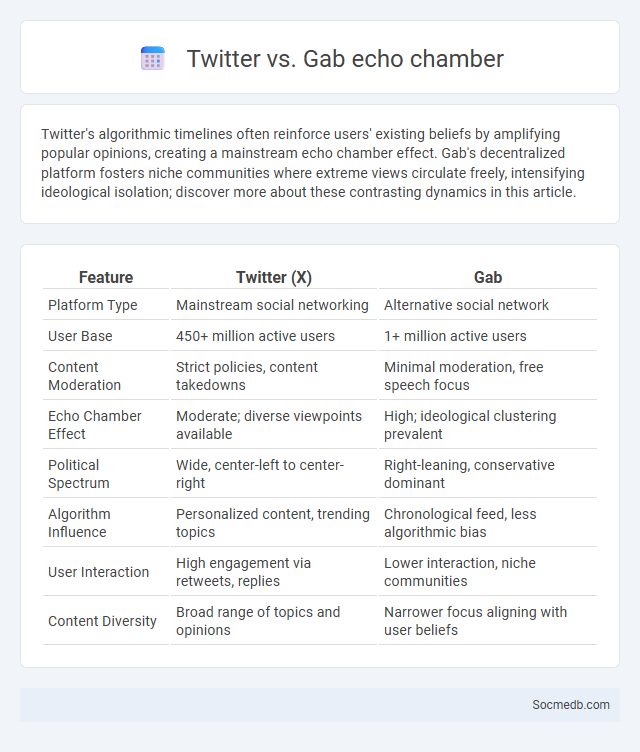
Photo illustration: Twitter vs Gab echo chamber
Twitter's algorithmic timelines often reinforce users' existing beliefs by amplifying popular opinions, creating a mainstream echo chamber effect. Gab's decentralized platform fosters niche communities where extreme views circulate freely, intensifying ideological isolation; discover more about these contrasting dynamics in this article.
Table of Comparison
| Feature | Twitter (X) | Gab |
|---|---|---|
| Platform Type | Mainstream social networking | Alternative social network |
| User Base | 450+ million active users | 1+ million active users |
| Content Moderation | Strict policies, content takedowns | Minimal moderation, free speech focus |
| Echo Chamber Effect | Moderate; diverse viewpoints available | High; ideological clustering prevalent |
| Political Spectrum | Wide, center-left to center-right | Right-leaning, conservative dominant |
| Algorithm Influence | Personalized content, trending topics | Chronological feed, less algorithmic bias |
| User Interaction | High engagement via retweets, replies | Lower interaction, niche communities |
| Content Diversity | Broad range of topics and opinions | Narrower focus aligning with user beliefs |
Understanding Echo Chambers: Twitter vs Gab
Echo chambers on social media platforms like Twitter and Gab amplify content that aligns with users' existing beliefs, limiting exposure to diverse perspectives. Twitter employs algorithmic curation designed to increase engagement by showing content similar to your interactions, which can reinforce confirmation bias. Gab, often attracting more niche or alternative communities, fosters echo chambers through less moderated content and a focus on free speech, creating environments where like-minded users primarily interact.
The Formation of Online Echo Chambers
Online echo chambers form when algorithms prioritize content that aligns with Your existing beliefs, creating a feedback loop that limits exposure to diverse perspectives. Social media platforms use personalized feeds to reinforce ideological boundaries, intensifying polarization and groupthink. This environment fosters the rapid spread of misinformation and deepens social divides, challenging critical thinking and open dialogue.
Algorithmic Influence: How Twitter and Gab Shape Discourse
Twitter's algorithm prioritizes trending topics and user engagement, amplifying popular opinions and shaping public discourse rapidly. Gab employs a different approach, emphasizing free speech with fewer content restrictions, which can foster niche communities but also polarizing content. Understanding these platforms' algorithmic influence helps you navigate and critically assess the information shaping your social conversations.
User Demographics and Ideological Segregation
Social media platforms exhibit significant user demographic variations, with age, gender, and cultural background influencing content consumption and interaction patterns. These differences contribute to ideological segregation, where algorithms tailor content to users' existing beliefs, reinforcing echo chambers and limiting exposure to diverse perspectives. Understanding how your social media habits align with these trends can help mitigate biases and promote more balanced information engagement.
Content Moderation and Its Effect on Echo Chambers
Content moderation on social media platforms significantly influences the formation and reinforcement of echo chambers by filtering the diversity of viewpoints available to users. Algorithms and moderation policies often prioritize engagement, which can amplify homogeneous content and limit exposure to opposing perspectives. This selective exposure strengthens users' preexisting beliefs, reducing ideological diversity and increasing polarization within online communities.
Virality and Misinformation Spread on Twitter and Gab
Twitter and Gab facilitate rapid content sharing, significantly amplifying the spread of viral information across global audiences. However, both platforms also contribute to the swift dissemination of misinformation due to their open network structures and limited content moderation policies. The algorithmic emphasis on engagement intensifies visibility for sensational or misleading posts, exacerbating challenges in verifying factual accuracy on these social media channels.
Community Dynamics: Reactions and Reinforcement Loops
Community dynamics on social media revolve around reactions such as likes, comments, and shares that create reinforcement loops, amplifying certain behaviors and content visibility. These loops shape user engagement by rewarding popular posts, influencing trends, and molding collective opinions within your network. Understanding these patterns helps you navigate and contribute effectively to digital communities.
Case Studies: Notable Echo Chamber Incidents
Notable echo chamber incidents on social media include the 2016 US presidential election, where algorithm-driven content reinforced users' political biases, intensifying polarization. The anti-vaccine movement also exemplifies echo chambers, with misinformation spreading rapidly within isolated communities, undermining public health efforts. Your understanding of these case studies highlights the critical need for diverse information exposure to combat echo chamber effects online.
Breaking Out: Strategies to Counter Digital Echo Chambers
Breaking out of digital echo chambers requires actively diversifying your social media feed by following accounts with varying perspectives and engaging in respectful dialogue across different communities. Utilizing algorithms designed to recommend contrasting viewpoints and fact-checking tools can help mitigate misinformation and broaden your understanding. Your conscious effort to seek out diverse content fosters critical thinking and promotes a healthier, more balanced digital environment.
The Future of Echo Chambers in Social Media Platforms
Echo chambers on social media platforms continue to evolve with advancements in algorithmic personalization and user behavior analytics, intensifying content silos that reinforce existing beliefs. Emerging technologies like artificial intelligence and blockchain aim to enhance content diversity and reduce filter bubbles, yet the challenge remains in balancing engagement with exposure to diverse viewpoints. Your awareness and proactive engagement strategies can help mitigate the deepening of echo chambers, fostering a more informed and connected digital environment.
 socmedb.com
socmedb.com